 |
Music is an abiding miracle – how else to explain a process that transforms synthetic abstract sound into soul-stirring human emotion? Vocals communicate directly, both through their lyrics and by emulating familiar speech patterns, but instruments present a more complex and elusive process. Blown or struck apparatus bear a resemblance to nature, but strings require the most extreme artifice – how else to explain a process that transforms synthetic abstract sound into soul-stirring human emotion? Vocals communicate directly, both through their lyrics and by emulating familiar speech patterns, but instruments present a more complex and elusive process. Blown or struck apparatus bear a resemblance to nature, but strings require the most extreme artifice – scraping horse hair over cat guts to evoke the most expressive of feelings. And of all the great works written for strings, perhaps Bach's Sonatas and Partitas for Solo Violin are the most wondrous – and rather mysterious as well. scraping horse hair over cat guts to evoke the most expressive of feelings. And of all the great works written for strings, perhaps Bach's Sonatas and Partitas for Solo Violin are the most wondrous – and rather mysterious as well.
One mystery the work avoids is authenticity. Unlike much of his output which scholars have had to reconstruct from copies and arrangements (and that's only the estimated half that hasn't been forever lost), we have Bach's original autograph score. And unlike most of his work that was forgotten after his death in 1750 and only rediscovered a century or more later, the Sonatas and Partitas remained popular. Although Bach never published them, violinists prized copies for their instructional value – not just for their technical challenges but for the wide range and profundity of expression they contain.
Written in 1720, the Sonatas and Partitas came at the exact midpoint of the three phases into which Bach's creative life is conveniently divided. From 1708 to 1717 Bach served as organist at Weimar and wrote most of his masterworks for the "king of instruments." From 1723 through the end of his life he was responsible for religious music at Leipzig, where he focused on cantatas, masses and other choral works. In between, he was employed at Cöthen by Prince Leopold. As a Calvinist, Leopold shunned religious music other than standard hymns and as an enthusiastic musician he encouraged Bach to focus on instrumental secular music. 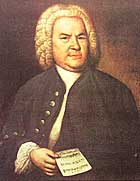 During this brief but fertile period, Bach was free from the demands of religious duties and could let his imagine soar. He was also happy, free from constant chafing against frugal and conservative authorities, and buoyed by an appreciative patron – at least until 1721 when Leopold took a wife hostile to art. During this brief but fertile period, Bach was free from the demands of religious duties and could let his imagine soar. He was also happy, free from constant chafing against frugal and conservative authorities, and buoyed by an appreciative patron – at least until 1721 when Leopold took a wife hostile to art.
The set consists of three sonatas and three partitas. The former follow the established model of the time to present a slow lyric introductory movement, followed by a fugue, a contrapuntal meditation and a brisk finale of rapid passagework. The partitas are suites of dances, although the second breaks away to conclude with arguably the greatest piece of music ever conceived for solo strings – a 15 minute chaconne in which a single idea resonates through 31 variations that embrace a universe of artistry and expression. While many of the dances are written in a single continuous voice, and thus suitable for a violin, most of the slower pieces and especially the fugues and the chaconne present a remarkable stylistic challenge – an attempt to convey multiple ideas and thick textures on an instrument capable of producing no more than two tones at once.
Consistent with his reputation at the time as a dry academic, Bach is rarely heard on the earliest records, but portions of the Sonatas and Partitas are a constant exception. Joseph Joachim (1831 - 1907) was an intimate friend of Mendelssohn, Schumann, Liszt and Brahms, who inspired and taught nearly every great violinist and all but defined classical performance in his time. 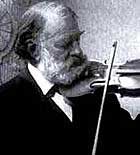 When he concluded his fabulous career in 1903 by cutting five records to preserve his artistry, he devoted two to Bach – the Adagio from the First Sonata and the Bourree from the First Partita. Their emphatic rhythm, colorful tone and uninhibited bowing heralded a deeply personal approach. His contemporary Pablo Sarasate (1844 - 1908), too, left a legacy on wax in 1904 – seven of his own works, a Chopin transcription and Bach – the Prelude to the Third Partita. Ironically, while Joachim stood for tradition and intellect and Sarasate was reputed for unbridled emotion, the latter's playing is far more mechanical, revelling in a sparkling if chaste display of the technical virtuosity for which he was famed. These first Bach records defined the extremes of interpretation for the legions who would follow. When he concluded his fabulous career in 1903 by cutting five records to preserve his artistry, he devoted two to Bach – the Adagio from the First Sonata and the Bourree from the First Partita. Their emphatic rhythm, colorful tone and uninhibited bowing heralded a deeply personal approach. His contemporary Pablo Sarasate (1844 - 1908), too, left a legacy on wax in 1904 – seven of his own works, a Chopin transcription and Bach – the Prelude to the Third Partita. Ironically, while Joachim stood for tradition and intellect and Sarasate was reputed for unbridled emotion, the latter's playing is far more mechanical, revelling in a sparkling if chaste display of the technical virtuosity for which he was famed. These first Bach records defined the extremes of interpretation for the legions who would follow.
Excerpts from the Sonatas and Partitas continued throughout the acoustical era with the next generation of violinists. While some sound rather prosaic, Kathleen Parlow plays the gavotte from the Third Partita in 1915 with great delicacy and balance (and a ravishing ending), and in 1922 Isolde Menges smoothly integrates the voices of the fugue from the First Sonata and shapes her phrases with utter conviction. But style must be suitable, as personality can overwhelm musical integrity –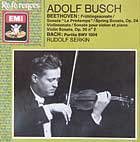 Henri Merkel smothers any sense of style or genuine expression in the minuets from the Third Partita with a syrupy goo of excessive vibrato. (All of the these plus many others are on The Recorded Violin, Pearl BVA I and II.) Henri Merkel smothers any sense of style or genuine expression in the minuets from the Third Partita with a syrupy goo of excessive vibrato. (All of the these plus many others are on The Recorded Violin, Pearl BVA I and II.)
With the advent of electrical recording, isolated movements ceded to entire sonatas and continued to reflect a wide range of personalities and styles. Adolph Busch led the way in 1929 with a magnificently humanized conception of the Second Partita in which his purity of tone is complemented rather than challenged by tasteful vibrato and portamento (sliding between climactic notes, a common expressive ornament of his time) to yield a fine balance of intellect and fantasy. By 1935 Szigeti, Heifetz and Milstein had issued competing versions of at least two sonatas or partitas, but all were superceded by their later versions.
The first complete set  emerged piecemeal from 1934 to 1936 (an integral release would have required an unwieldy set of nineteen 78s!) from an unlikely source – Yehudi Menuhin, then a mere teenager (now on EMI or Naxos). Notwithstanding its historical importance, the overall impression is more of sheer intrepid momentum than memorable personality, subtlety or style. Perhaps appropriate for a pioneering venture, Menuhin plunges ahead and saws away fearlessly, although he does provide a sense of focus and pensiveness by relaxing many of the faster dances. emerged piecemeal from 1934 to 1936 (an integral release would have required an unwieldy set of nineteen 78s!) from an unlikely source – Yehudi Menuhin, then a mere teenager (now on EMI or Naxos). Notwithstanding its historical importance, the overall impression is more of sheer intrepid momentum than memorable personality, subtlety or style. Perhaps appropriate for a pioneering venture, Menuhin plunges ahead and saws away fearlessly, although he does provide a sense of focus and pensiveness by relaxing many of the faster dances.
Perhaps fittingly, the 78 era of the Sonatas and Partitas closed with a 1949 set (now on Allegro) by Menuhin's aged teacher, Georges Enescu, an extraordinary musician equally famed as a pedagogue, composer, conductor, advocate of musical education – and violinist. You may wince at his intonation without never quite being sure if it's due to ravaged technique or an intentional bending of notes to exemplify the outlook he gained from having learned to fiddle with the gypsys of his native Roumania. Earthy and soulful, his is deeply personal, passionate and altogether unique playing, bristling with spontaneity and conviction. the 78 era of the Sonatas and Partitas closed with a 1949 set (now on Allegro) by Menuhin's aged teacher, Georges Enescu, an extraordinary musician equally famed as a pedagogue, composer, conductor, advocate of musical education – and violinist. You may wince at his intonation without never quite being sure if it's due to ravaged technique or an intentional bending of notes to exemplify the outlook he gained from having learned to fiddle with the gypsys of his native Roumania. Earthy and soulful, his is deeply personal, passionate and altogether unique playing, bristling with spontaneity and conviction.
The advent of the LP spawned a bounty of integral sets, of which many are still widely admired. Nathan Milstein is rhythmically assertive and unabashedly virtuostic, both in a 1973 DG stereo remake and even more so in 1954-6 EMI mono. Henryk Szeryng (1954, no CD, or 1960s on DG) outlines the structures by phrasing with dynamic and rhythmic subtlety and varying the tone through his delicate bowing. Arthur Grumiaux (Philips) emphasizes the music's sheer beauty, but his shimmering gloss is so sweet and smooth that it drains the music of its inherent drama. spawned a bounty of integral sets, of which many are still widely admired. Nathan Milstein is rhythmically assertive and unabashedly virtuostic, both in a 1973 DG stereo remake and even more so in 1954-6 EMI mono. Henryk Szeryng (1954, no CD, or 1960s on DG) outlines the structures by phrasing with dynamic and rhythmic subtlety and varying the tone through his delicate bowing. Arthur Grumiaux (Philips) emphasizes the music's sheer beauty, but his shimmering gloss is so sweet and smooth that it drains the music of its inherent drama.
The playing of Jascha Heifetz is often maligned as cold, mechanical and unfeeling. But not in his 1952 set of the Sonatas and Partitas (BMG 67148), though. His complete mastery of the technical challenges allowed him a unique opportunity – to transcend practical limitations to draw us to a rarified level where the barest of inflection wields a surprisingly powerful impact. With others, there's an unavoidable tension in negotiating the mechanical hurdles. Heifetz alone enables the listener to bask in the purity of abstract music, a vision constantly alive with the subtlest of emotional shading. is often maligned as cold, mechanical and unfeeling. But not in his 1952 set of the Sonatas and Partitas (BMG 67148), though. His complete mastery of the technical challenges allowed him a unique opportunity – to transcend practical limitations to draw us to a rarified level where the barest of inflection wields a surprisingly powerful impact. With others, there's an unavoidable tension in negotiating the mechanical hurdles. Heifetz alone enables the listener to bask in the purity of abstract music, a vision constantly alive with the subtlest of emotional shading.
Far more personal was Joseph Szigeti,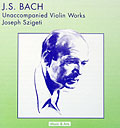 who explored Bach with brimming imagination and huge expressivity. He cut the first two Sonatas in 1931 and 1933 (Biddulph 153) with huge tempo variation, not only to underline the overall structure but to emphasize the force of individual notes within individual phrases and to deemphasize the melody within the polyphonic context. Yet, his tone remains teasingly sweet, as if to insist that the listener join him to plunge beneath the superficially calm surface; indeed, it's hard to imagine that this is the same artist who kept pace with Bartok's rough and tumble playing in their famed recitals. In a 1946 New York concert (Music and Arts 774) his slow movements emerged as soulful and exquisite but in the faster ones emotion often overwhelmed his deteriorating technique. By the time he cut his integral set in 1955-6 (Bach Guild 1246) he clearly was struggling, yet managed to impart an aura of deeply personal involvement that gave his set a uniquely improvisatory feeling. who explored Bach with brimming imagination and huge expressivity. He cut the first two Sonatas in 1931 and 1933 (Biddulph 153) with huge tempo variation, not only to underline the overall structure but to emphasize the force of individual notes within individual phrases and to deemphasize the melody within the polyphonic context. Yet, his tone remains teasingly sweet, as if to insist that the listener join him to plunge beneath the superficially calm surface; indeed, it's hard to imagine that this is the same artist who kept pace with Bartok's rough and tumble playing in their famed recitals. In a 1946 New York concert (Music and Arts 774) his slow movements emerged as soulful and exquisite but in the faster ones emotion often overwhelmed his deteriorating technique. By the time he cut his integral set in 1955-6 (Bach Guild 1246) he clearly was struggling, yet managed to impart an aura of deeply personal involvement that gave his set a uniquely improvisatory feeling.
More personal still is a 1995 account by Ida Haendel,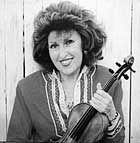 a pupil of Enescu, who blends discipline and freedom into a monumental vision, its magisterial pace barely contained on two CDs (Testament 2090). Her rhythm is bracingly steady yet emphatic; her texture firm without being percussive or harsh; her impression heartfelt and distinctive while maintaining full respect for Bach�s architecture and the integrity of his score. As she puts it, her Bach is not a mythical, aloof intellectualized figure but rather a man, �with all the emotions and feelings of a human being – the drama, the tempest, the tragedy and the tears are all there. In this music is the whole spectrum of life and death.� Her chaconne (a luxuriant 18 minutes) is, to her, �the shattering resignation of a man to his unavoidable tragic destiny.� Indeed, in her hands not only the chaconne but the entire set from start to finish is an intense and deeply moving journey. a pupil of Enescu, who blends discipline and freedom into a monumental vision, its magisterial pace barely contained on two CDs (Testament 2090). Her rhythm is bracingly steady yet emphatic; her texture firm without being percussive or harsh; her impression heartfelt and distinctive while maintaining full respect for Bach�s architecture and the integrity of his score. As she puts it, her Bach is not a mythical, aloof intellectualized figure but rather a man, �with all the emotions and feelings of a human being – the drama, the tempest, the tragedy and the tears are all there. In this music is the whole spectrum of life and death.� Her chaconne (a luxuriant 18 minutes) is, to her, �the shattering resignation of a man to his unavoidable tragic destiny.� Indeed, in her hands not only the chaconne but the entire set from start to finish is an intense and deeply moving journey.
Yet, there's a fundamental problem with all this – the Sonatas and Partitas are not merely difficult but impossible to play as written. How can that be, given the array of fine interpretations?  Consider the first two measures of the Chaconne, which feature three and then four held notes – a flat bow surface drawn across strings arrayed across a convex bridge can comfortably play two at a time, or perhaps three with a flatter bridge and reduced bow tension, but four only with an ugly, strained sonority. Worse, in those same two measures half-notes appear simultaneously with dotted quarter and eighth notes – either the bow moves continuously or it differentiates notes by pausing or changing direction; here, too, rocking the bow to momentarily cut off an outer string might work with three strings, but not four. Consider the first two measures of the Chaconne, which feature three and then four held notes – a flat bow surface drawn across strings arrayed across a convex bridge can comfortably play two at a time, or perhaps three with a flatter bridge and reduced bow tension, but four only with an ugly, strained sonority. Worse, in those same two measures half-notes appear simultaneously with dotted quarter and eighth notes – either the bow moves continuously or it differentiates notes by pausing or changing direction; here, too, rocking the bow to momentarily cut off an outer string might work with three strings, but not four.
So how do violinists play these and similar passages? They cheat! Sustained chords are arpeggiated, either by quickly rolling them or by breaking them into two sequential chords of two notes each, and long notes are broken into the rhythms of the shorter ones.
While justified as a practical necessity, is this historically valid? That, too, is debatable.  Bows stretch a length of horse hair between a fixed tip and a moveable frog adjusted by a screw to relax the tension normally and then tighten it for use. Musicologists once assumed that Bach meant what he wrote and theorized that players kept the frog in place with their thumb, thus enabling continuous adjustment of the tautness and curvature of the hair to play a single note or to wrap around three or four strings to sound a chord. Bows stretch a length of horse hair between a fixed tip and a moveable frog adjusted by a screw to relax the tension normally and then tighten it for use. Musicologists once assumed that Bach meant what he wrote and theorized that players kept the frog in place with their thumb, thus enabling continuous adjustment of the tautness and curvature of the hair to play a single note or to wrap around three or four strings to sound a chord.  Indeed, in the Chaconne, Bach twice specifies that a passage of chords should be arpeggiated (and even writes out the first two groups to show how – see the illustration above), thus seeming to suggest that other segments lacking such notation should not be. In 1954 Emil Telmanyi made a fascinating recording (Testament 1257), with a special bow he commissioned with adjustable tension, so that when Bach indicates three or all four strings sounding at once that's just what we hear – a constantly evolving ambiance with enriched textures, harmonies fully apparent, and smooth transitions among layers of voice. But no historical example nor even a reference to similar bows has ever been found, and so Telmanyi's approach, while intriguing, is considered a modern experiment. Indeed, in the Chaconne, Bach twice specifies that a passage of chords should be arpeggiated (and even writes out the first two groups to show how – see the illustration above), thus seeming to suggest that other segments lacking such notation should not be. In 1954 Emil Telmanyi made a fascinating recording (Testament 1257), with a special bow he commissioned with adjustable tension, so that when Bach indicates three or all four strings sounding at once that's just what we hear – a constantly evolving ambiance with enriched textures, harmonies fully apparent, and smooth transitions among layers of voice. But no historical example nor even a reference to similar bows has ever been found, and so Telmanyi's approach, while intriguing, is considered a modern experiment.  (As if to prove that serious musicians aren't always the innovators, a 1927 Vitaphone short with the "Jazzmania Quintet" features George Stoll, who removes his frog, threads his violin between hair and stick, and then plays a fluid chorus with an inverted bow, thus presaging Telmanyi's discovery by three decades!) (As if to prove that serious musicians aren't always the innovators, a 1927 Vitaphone short with the "Jazzmania Quintet" features George Stoll, who removes his frog, threads his violin between hair and stick, and then plays a fluid chorus with an inverted bow, thus presaging Telmanyi's discovery by three decades!)
Indeed, the very notion of rediscovering Baroque performance practice has far less relevance for strings than other instruments. While keyboards, winds, brass and percussion have evolved considerably in the last 300 years and bear scant resemblance to their forebears, aside from relatively slight modifications in their fittings violins, violas and celli have remained largely constant.  Indeed, the most prized string instruments of our time were made in the Italian workshops of Amati, Guarneri, Stradivarius and others up to two generations before Bach. Indeed, the most prized string instruments of our time were made in the Italian workshops of Amati, Guarneri, Stradivarius and others up to two generations before Bach.
In the notes to his historically-informed readings (Nonesuch 73030), Sergiu Luca not only derides Telmanyi's bow as grotesque but goes on to dispel as myth any attempt to treat Bach's writing as chordal. Rather, he considers the overlay of notes to represent linear movement of independent voices which the player must differentiate through the quality of his tone. 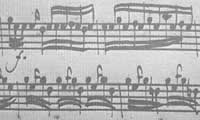 Luca's view is supported by Bach's autograph – in several passages he writes repeated notes not continuously (as efficient notation would suggest) but with different groupings, so as to suggest that they not be played uniformly but rather as part of interlocking discrete lines. (Thus, in the staves in the illustration at right the upper beams and flags might signify notes to be played on the open E string, while the others would be fingered on the A string so as to subtly differentiate their sound.) Luca's view is supported by Bach's autograph – in several passages he writes repeated notes not continuously (as efficient notation would suggest) but with different groupings, so as to suggest that they not be played uniformly but rather as part of interlocking discrete lines. (Thus, in the staves in the illustration at right the upper beams and flags might signify notes to be played on the open E string, while the others would be fingered on the A string so as to subtly differentiate their sound.)
Many commentators have come to consider the Sonatas and Partitas the apex of Bach's natural affinity for polyphony (the vertical interplay of separate musical lines). In keeping with their aesthetic, many eminent 19th century artists (including Mendelssohn and Schumann) felt compelled to treat the violin score as mere melody and added a piano part to fill in the harmony.  Yet, Bach took great care to avoid such treatment – not only did he label the cover page "Sei soli a violino senza Basso accompagnato" ("six solos for violin without bass accompaniment") but he emphatically repeated this admonition at the beginning of each piece. Bernard Jacobson noted with some irony that only now, in light of modern musical trends, are we sufficiently free of the tyranny of harmonized melody to be able to "hear" Bach the way he intended. Yet, Bach took great care to avoid such treatment – not only did he label the cover page "Sei soli a violino senza Basso accompagnato" ("six solos for violin without bass accompaniment") but he emphatically repeated this admonition at the beginning of each piece. Bernard Jacobson noted with some irony that only now, in light of modern musical trends, are we sufficiently free of the tyranny of harmonized melody to be able to "hear" Bach the way he intended.
As historian Tully Potter observed, Bach's skillful writing imbues the solo with a harmonic drift that implies extra voices that aren't actually present. Musicologist Sidney Finkelstein agreed that Bach wrote in such a way that the listener could subconsciously fill in the harmonic plan without ever hearing it. He lauds the elegance of Bach's writing as an inspired economy that manages to suggest continuity with discontinuous means. Thus, the extreme leaps comprise not a wide-spread melody but rather a set of fragments of a complete multi-part score. Just as a black and white movie forces you to infer color or a flat painting to perceive depth, Bach gives us just enough clues to "hear" a quartet's worth of sound from a single violin. Bach's glory is to require the listener to become involved in the process of filling in the "missing" parts to create a complete aural image from the barely sufficient clues he provides. Thus, Bach's music only seems superficially simple; rather, his art demands that the listener participate in the act of creation and repays the effort with a far more personal and satisfying result than would be experienced by a typically passive member of an audience at a conventional recital.
Yet the mystery deepens. Unlike most of Bach's surviving autographs, the Sonatas and Partitas are fully written out, with all ornaments, dynamics and phrasing profusely detailed. Indeed, Bach often seems to urge expression through lovely sensitive curved slurs and beam lines.   (Consider, for example, the implications of the complex and lively shape of the slur and graceful wavy beam lines in the passage in the illustration, especially when compared with their counterparts in the modern printed version, which not only appears dry, mechanical and lifeless but falsifies the asymetrical phrasing into three sets of eight notes rather than Bach's clear indication of a far more interesting group of eight followed by sixteen.) (Consider, for example, the implications of the complex and lively shape of the slur and graceful wavy beam lines in the passage in the illustration, especially when compared with their counterparts in the modern printed version, which not only appears dry, mechanical and lifeless but falsifies the asymetrical phrasing into three sets of eight notes rather than Bach's clear indication of a far more interesting group of eight followed by sixteen.)
So for whom did Bach write these works? And why? Shirley Fleming felt that the Sonatas and Partitas were written not for an occasion but for Bach's own pure intellectual pleasure. Yet, Bach himself was an accomplished violinist (he began his musical career in that post), and would have had no need for such meticulous notation to remind himself of his own intentions. Others suggest that he wrote them for other violinists of his time. But that, too, seems doubtful, as their rigorous training imbued them with the knowledge of how to infer a stylish performance from a bare written outline, to which all the detail of Bach's score would have been utterly redundant.
Here's my guess, although it owes more to science fiction than to credible scholarship. I view these works as a time capsule. Even at the mid-point of his life, Bach knew that his beloved polyphonic music, to which he was deeply devoted as symbolic of God, was becoming pass�. He was right: indeed, his own sons composed in the emerging "modern" fashion of harmonized melody that would dominate the next 150 years (and that remains the basis for popular music to this day). It's generally accepted that Bach intended his massive Art of the Fugue, left unfinished at his death, as a summation of his aesthetic. Perhaps the Sonatas and Partitas were an even earlier legacy, a master's precise instruction manual intended to provide musicians of future generations with a key of authenticity to unlock the principles and exhibit the full glory of a style that meant everything to Bach but which he feared might otherwise be forever lost.

Copyright 2004 by Peter Gutmann
|
